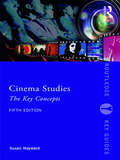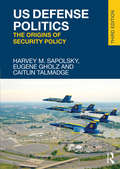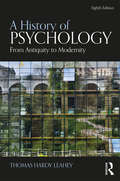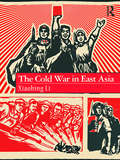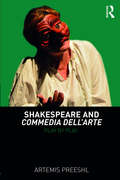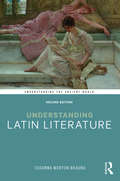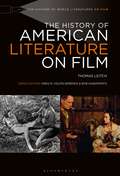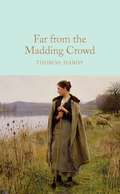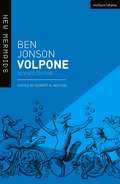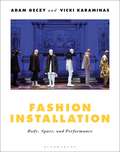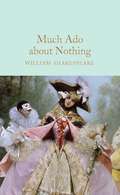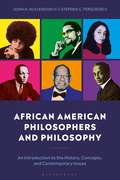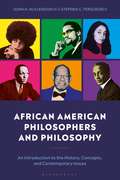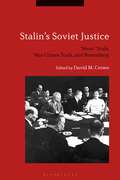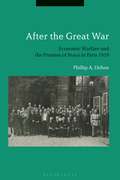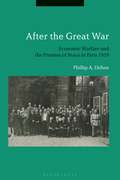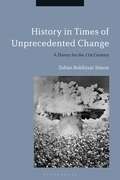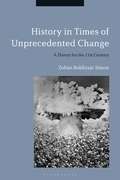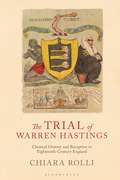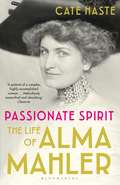- Table View
- List View
Cinema Studies: The Key Concepts (Routledge Key Guides)
by Susan HaywardCinema Studies: The Key Concepts is essential reading for anyone interested in film. Providing accessible coverage of a comprehensive range of genres, movements, theories and production terms, this is a must-have guide to a fascinating area of study and arguably the greatest art form of modern times. Now fully revised and updated for its fifth edition, the book includes entries on topics such as: Acting Audience CGI Convergence Cult cinema Digitisation and globalization Distribution Experimental film Transnational cinema World cinemas
US Defense Politics: The Origins of Security Policy
by Harvey M. Sapolsky Eugene Gholz Caitlin TalmadgeThis book provides an accessible overview of US defense politics for upper-level students. This new edition has been fully updated and revised, with a new chapter on veterans and new material on topics such as cyberwarfare and lobbying. Analyzing the ways in which the United States prepares for war, the authors demonstrate how political and organizational interests determine US defense policy and warn against over-emphasis on planning, centralization, and technocracy. Emphasizing the process of defense policy-making rather than just the outcomes of that process, US Defense Politics departs from the traditional style of many other textbooks. Designed to help students understand the practical side of American national security policy, the book examines the following key themes: US grand strategy; who joins America's military; how and why weapons are bought; the management of defense; public attitudes toward the military and casualties; the roles of the president and the Congress in controlling the military; the effects of 9/11 and the Global War on Terror on security policy, homeland security, government reorganizations, and intra- and inter-service relations. The third edition will be essential reading for students of US defense politics, national security policy, and homeland security, and highly recommended for students of US foreign policy, public policy, and public administration.
A History of Psychology: From Antiquity to Modernity
by Thomas Hardy LeaheyA History of Psychology places social, economic, and political forces of change alongside psychology’s internal theoretical and empirical arguments, illuminating how the external world has shaped psychology’s development, and, in turn, how the late twentieth century’s psychology has shaped society. Featuring extended treatment of important movements such as the Enlightenment and the Scientific Revolution, the textbook approaches the material from an integrative rather than wholly linear perspective. The text carefully examines how issues in psychology reflect and affect concepts that lie outside the field of psychology’s technical concerns as a science and profession. This new edition features expanded attention on psychoanalysis after its founding as well as new developments in cognitive science, artificial intelligence, and behavioral economics. Throughout, the book strengthens its exploration of psychological ideas and the cultures in which they developed and reinforces the connections between psychology, modernism, and postmodernism. The textbook covers scientific, applied, and professional psychology, and is appropriate for higher-level undergraduate and graduate students.
The Cold War in East Asia
by Xiaobing LiThis textbook provides a survey of East Asia during the Cold War from 1945 to 1991. Focusing on the persistence and flexibility of its culture and tradition when confronted by the West and the US, this book investigates how they intermesh to establish the nations that have entered the modern world. Through the use of newly declassified Communist sources, the narrative helps students form a better understanding of the origins and development of post-WWII East Asia. The analysis demonstrates how East Asia’s position in the Cold War was not peripheral but, in many key senses, central. The active role that East Asia played, ultimately, turned this main Cold War battlefield into a "buffer" between the United States and the Soviet Union. Covering a range of countries, this textbook explores numerous events, which took place in East Asia during the Cold War, including: The occupation of Japan, Civil war in China and the establishment of Taiwan, The Korean War, The Vietnam War, China’s Reforming Movement. Moving away from Euro-American centric approaches and illuminating the larger themes and patterns in the development of East Asian modernity, The Cold War in East Asia is an essential resource for students of Asian History, the Cold War and World History.
Shakespeare and Commedia dell'Arte: Play by Play
by Artemis PreeshlShakespeare and Commedia dell’Arte examines the ongoing influence of commedia dell’arte on Shakespeare’s plays. Exploring the influence of commedia dell’arte improvisation, sight gags, and wordplay on the development of Shakespeare’s plays, Artemis Preeshl blends historical research with extensive practical experience to demonstrate how these techniques might be applied when producing some of Shakespeare's best-known works today. Each chapter focuses on a specific play, from A Midsummer Night’s Dream to The Winter’s Tale, drawing out elements of commedia dell’arte style in the playscripts and in contemporary performance. Including contemporary directors’ notes and interviews with actors and audience members alongside Elizabethan reviews, criticism, and commentary, Shakespeare and Commedia dell’Arte presents an invaluable resource for scholars and students of Renaissance theatre.
Understanding Latin Literature (Understanding the Ancient World)
by Susanna Morton BraundUnderstanding Latin Literature is a highly accessible, user-friendly work that provides a fresh and illuminating introduction to the most important aspects of Latin prose and poetry. This second edition is heavily revised to reflect recent developments in scholarship, especially in the area of the later reception and reverberations of Latin literature. Chapters are dedicated to Latin writers such as Virgil and Livy and explore how literature related to Roman identity and society. Readers are stimulated and inspired to do their own further reading through engagement with a wide selection of translated extracts and through understanding the different ways in which they can be approached. Central throughout is the theme of the fundamental connections between Latin literature and issues of elite Roman culture. The versatile and accessible structure of Understanding Latin Literature makes it suitable for both individual and class use.
The History of American Literature on Film (The History of World Literatures on Film)
by Thomas LeitchFrom William Dickson's Rip Van Winkle films (1896) to Baz Luhrmann's big-budget production of The Great Gatsby (2013) and beyond, cinematic adaptations of American literature participate in a rich and fascinating history. Unlike previous studies of American literature and film, which emphasize particular authors like Edith Wharton and Nathaniel Hawthorne, particular texts like Moby-Dick, particular literary periods like the American Renaissance, or particular genres like the novel, this volume considers the multiple functions of filmed American literature as a cinematic genre in its own right-one that reflects the specific political and aesthetic priorities of different national and historical cinemas even as it plays a decisive role in defining American literature for a global audience.
The History of American Literature on Film (The History of World Literatures on Film)
by Thomas LeitchFrom William Dickson's Rip Van Winkle films (1896) to Baz Luhrmann's big-budget production of The Great Gatsby (2013) and beyond, cinematic adaptations of American literature participate in a rich and fascinating history. Unlike previous studies of American literature and film, which emphasize particular authors like Edith Wharton and Nathaniel Hawthorne, particular texts like Moby-Dick, particular literary periods like the American Renaissance, or particular genres like the novel, this volume considers the multiple functions of filmed American literature as a cinematic genre in its own right-one that reflects the specific political and aesthetic priorities of different national and historical cinemas even as it plays a decisive role in defining American literature for a global audience.
Far From the Madding Crowd: The Wild And Wanton Edition (Macmillan Collector's Library #195)
by Thomas HardyFar From the Madding Crowd was the first of Hardy’s novels to give the name of Wessex to the landscape of south-west England and is set against the backdrop of the unchanging natural cycle of the year. The story both upholds and questions rural values with a startlingly modern sensibility.Part of the Macmillan Collector’s Library; a series of stunning, clothbound, pocket sized classics with gold foiled edges and ribbon markers. These beautiful books make perfect gifts or a treat for any book lover. This edition features original illustrations by Helen Allingham and an introduction by Professor Mark Ford.Gabriel Oak is only one of three suitors for the hand of the beautiful and spirited Bathsheba Everdene. He must compete with the dashing young soldier Sergeant Troy and respectable, middle-aged Farmer Boldwood. And while their fates depend upon the choice Bathsheba makes, she discovers the terrible consequences of an inconstant heart.
Volpone: Revised Edition (New Mermaids)
by Ben JonsonThe sharpest, funniest comedy about money and morals in the 17th century is still the sharpest and funniest about those things in the 21st. The full, modernised play text is accompanied by incisive commentary notes which communicate the devastating comic energy of Volpone's satire. The introduction provides a firm grounding in the play's social and literary contexts, demonstrates how careful close-reading can expand your enjoyment of the comedy, shows the relevance of Jonson's critique to our modern economic systems, and provides a clear picture of how the main relationships in the play function on the page and stage. Supplemented by a plot summary and annotated bibliography, it is ideal for students of Jonson, city comedy and early modern drama.
Volpone: Revised Edition (New Mermaids)
by Ben JonsonThe sharpest, funniest comedy about money and morals in the 17th century is still the sharpest and funniest about those things in the 21st. The full, modernised play text is accompanied by incisive commentary notes which communicate the devastating comic energy of Volpone's satire. The introduction provides a firm grounding in the play's social and literary contexts, demonstrates how careful close-reading can expand your enjoyment of the comedy, shows the relevance of Jonson's critique to our modern economic systems, and provides a clear picture of how the main relationships in the play function on the page and stage. Supplemented by a plot summary and annotated bibliography, it is ideal for students of Jonson, city comedy and early modern drama.
Fashion Installation: Body, Space, and Performance
by Adam Geczy Vicki KaraminasGone are the days when fashion relied on a runway launch with coinciding press promotions to show a couturier's new range. Today, design houses are thinking beyond traditional methods of display to stimulate interest in their collections, such as to the internet, fashion film and, more recently, fashion installations. This book offers a critical evaluation of the changing ways in which fashion has been exhibited, focusing specifically on the recent turn toward installation, whether in the form of static presentations, interactive performances or the more conventional curated designer exhibition. Connecting viewers – and consumers – on an immersive level, the fashion world has begun to appropriate installation methods traditionally associated with displays of experimental art, transcending the runway system and its constraints. This book turns to the designers who have pioneered fashion installations, such as Aitor Throup, Muccia Prada, Walter Van Beirendonck and Hussein Chalayan among others, and also looks back to the early influential fashion displays by designers such as Worth and Poiret to provide historical context. Divided into three parts, and covering a variety of installations from Vivienne Westwood's fashioned 'concept' stores to Gareth Pugh's immersive films, this ground-breaking book positions the designer as the curator and exhibition-maker and offers the first focused study of the pertinent concept of fashion installation.
Fashion Installation: Body, Space, and Performance
by Adam Geczy Vicki KaraminasGone are the days when fashion relied on a runway launch with coinciding press promotions to show a couturier's new range. Today, design houses are thinking beyond traditional methods of display to stimulate interest in their collections, such as to the internet, fashion film and, more recently, fashion installations. This book offers a critical evaluation of the changing ways in which fashion has been exhibited, focusing specifically on the recent turn toward installation, whether in the form of static presentations, interactive performances or the more conventional curated designer exhibition. Connecting viewers – and consumers – on an immersive level, the fashion world has begun to appropriate installation methods traditionally associated with displays of experimental art, transcending the runway system and its constraints. This book turns to the designers who have pioneered fashion installations, such as Aitor Throup, Muccia Prada, Walter Van Beirendonck and Hussein Chalayan among others, and also looks back to the early influential fashion displays by designers such as Worth and Poiret to provide historical context. Divided into three parts, and covering a variety of installations from Vivienne Westwood's fashioned 'concept' stores to Gareth Pugh's immersive films, this ground-breaking book positions the designer as the curator and exhibition-maker and offers the first focused study of the pertinent concept of fashion installation.
Much Ado About Nothing: Webster's Spanish Thesaurus Edition (Macmillan Collector's Library #193)
by William ShakespeareComedy and tragedy intertwine when two very different couples fall in and out of love. Part of the Macmillan Collector’s Library; a series of stunning, clothbound, pocket sized classics with gold foiled edges and ribbon markers. These beautiful books make perfect gifts or a treat for any book lover. This edition features illustrations by renowned artist Sir John Gilbert and a new introduction from Professor Tiffany Stern.Whilst Beatrice and Benedick both despise love, exchanging insults and mockery rather than vows, for Hero and Claudio it is love at first sight. But as their marriage preparations begin, so too do Don John’s dirty tricks. Can his scheming get in the way of true love? And can an elaborate plan to bring fiery Beatrice and cynical Benedick closer together really come off? In Much Ado About Nothing, one of Shakespeare’s most popular plays, nothing is quite what it seems.
African American Philosophers and Philosophy: An Introduction to the History, Concepts and Contemporary Issues
by Stephen Ferguson II John McClendon IIIThis book presents the first introduction to African American academic philosophers, exploring their concepts and ideas and revealing the critical part they have played in the formation of philosophy in the USA.The book begins with the early years of educational attainment by African American philosophers in the 1860s. To demonstrate the impact of their philosophical work on general problems in the discipline, chapters are broken down into four major areas of study: Axiology, Social Science, Philosophy of Religion and Philosophy of Science. Providing personal narratives on individual philosophers and examining the work of figures such as H. T. Johnson, William D. Johnson, Joyce Mitchell Cooke, Adrian Piper, William R. Jones, Roy D. Morrison, Eugene C. Holmes, and William A. Banner, the book challenges the myth that philosophy is exclusively a white academic discipline. Packed with examples of struggles and triumphs, this engaging introduction is a much-needed approach to studying philosophy today.
African American Philosophers and Philosophy: An Introduction to the History, Concepts and Contemporary Issues
by Stephen Ferguson II John McClendon IIIThis book presents the first introduction to African American academic philosophers, exploring their concepts and ideas and revealing the critical part they have played in the formation of philosophy in the USA.The book begins with the early years of educational attainment by African American philosophers in the 1860s. To demonstrate the impact of their philosophical work on general problems in the discipline, chapters are broken down into four major areas of study: Axiology, Social Science, Philosophy of Religion and Philosophy of Science. Providing personal narratives on individual philosophers and examining the work of figures such as H. T. Johnson, William D. Johnson, Joyce Mitchell Cooke, Adrian Piper, William R. Jones, Roy D. Morrison, Eugene C. Holmes, and William A. Banner, the book challenges the myth that philosophy is exclusively a white academic discipline. Packed with examples of struggles and triumphs, this engaging introduction is a much-needed approach to studying philosophy today.
Stalin's Soviet Justice: ‘Show’ Trials, War Crimes Trials, and Nuremberg
by David M. CroweFrom the 'show' trials of the 1920s and 1930s to the London Conference, this book examines the Soviet role in the Nuremberg IMT trial through the prism of the ideas and practices of earlier Soviet legal history, detailing the evolution of Stalin's ideas about the trail of Nazi war criminals. Stalin believed that an international trial for Nazi war criminals was the best way to show the world the sacrifices his country had made to defeat Hitler, and he, together with his legal mouthpiece Andrei Vyshinsky, maintained tight control over Soviet representatives during talks leading up to the creation of the Nuremberg IMT trial in 1945, and the trial itself. But Soviet prosecutors at Nuremberg were unable to deal comfortably with the complexities of an open, western-style legal proceeding, which undercut their effectiveness throughout the trial. However, they were able to present a significant body of evidence that underscored the brutal nature of Hitler's racial war in Russia from 1941-45, a theme which became central to Stalin's efforts to redefine international criminal law after the war.Stalin's Soviet Justice provides a nuanced analysis of the Soviet justice system at a crucial turning point in European history and it will be vital reading for scholars and advanced students of the legal history of the Soviet Union, the history of war crimes and the aftermath of the Second World War.
Stalin's Soviet Justice: ‘Show’ Trials, War Crimes Trials, and Nuremberg
by David M. CroweFrom the 'show' trials of the 1920s and 1930s to the London Conference, this book examines the Soviet role in the Nuremberg IMT trial through the prism of the ideas and practices of earlier Soviet legal history, detailing the evolution of Stalin's ideas about the trail of Nazi war criminals. Stalin believed that an international trial for Nazi war criminals was the best way to show the world the sacrifices his country had made to defeat Hitler, and he, together with his legal mouthpiece Andrei Vyshinsky, maintained tight control over Soviet representatives during talks leading up to the creation of the Nuremberg IMT trial in 1945, and the trial itself. But Soviet prosecutors at Nuremberg were unable to deal comfortably with the complexities of an open, western-style legal proceeding, which undercut their effectiveness throughout the trial. However, they were able to present a significant body of evidence that underscored the brutal nature of Hitler's racial war in Russia from 1941-45, a theme which became central to Stalin's efforts to redefine international criminal law after the war.Stalin's Soviet Justice provides a nuanced analysis of the Soviet justice system at a crucial turning point in European history and it will be vital reading for scholars and advanced students of the legal history of the Soviet Union, the history of war crimes and the aftermath of the Second World War.
After the Great War: Economic Warfare and the Promise of Peace in Paris 1919
by Phillip DehneAt the Paris Peace Conference of 1919, the international community came together to find a way forward in the aftermath of the First World War. The conference is often judged a failure, as the resulting Treaty of Versailles did not bring long-term peace with Germany. By following the activities of British delegate and wartime Minister of Blockade Lord Robert Cecil, this book examines the struggles and successes of the conference, as delegates from around the world grappled with the economic, political and humanitarian catastrophes overwhelming Europe in 1919. After the Great War describes, for the first time, the significant role of economic warfare at the Peace Conference and in the post-war settlement. Lord Cecil's sometimes difficult partnership with US President Woodrow Wilson forged a new, permanent, international diplomatic organization – the League of Nations – and supplied it with the power to create collective blockades against aggressive states. Leaders of the Allied economic war before the Armistice became, in Paris, leaders of humanitarian-minded international outreach to their former enemies in Germany and Austria. After the Great War promotes a new understanding of these underappreciated internationalists in Paris, many of whom transitioned into leading the League of Nations even before the Peace Conference ended. Often derided as an idealistic fantasy, international peace enforced by economic sanctions appeared a realistic possibility when the Treaty was signed at the end of June 1919.
After the Great War: Economic Warfare and the Promise of Peace in Paris 1919
by Phillip DehneAt the Paris Peace Conference of 1919, the international community came together to find a way forward in the aftermath of the First World War. The conference is often judged a failure, as the resulting Treaty of Versailles did not bring long-term peace with Germany. By following the activities of British delegate and wartime Minister of Blockade Lord Robert Cecil, this book examines the struggles and successes of the conference, as delegates from around the world grappled with the economic, political and humanitarian catastrophes overwhelming Europe in 1919. After the Great War describes, for the first time, the significant role of economic warfare at the Peace Conference and in the post-war settlement. Lord Cecil's sometimes difficult partnership with US President Woodrow Wilson forged a new, permanent, international diplomatic organization – the League of Nations – and supplied it with the power to create collective blockades against aggressive states. Leaders of the Allied economic war before the Armistice became, in Paris, leaders of humanitarian-minded international outreach to their former enemies in Germany and Austria. After the Great War promotes a new understanding of these underappreciated internationalists in Paris, many of whom transitioned into leading the League of Nations even before the Peace Conference ended. Often derided as an idealistic fantasy, international peace enforced by economic sanctions appeared a realistic possibility when the Treaty was signed at the end of June 1919.
History in Times of Unprecedented Change: A Theory for the 21st Century
by Zoltán Boldizsár SimonOur understanding of ourselves and the world as historical has drastically changed since the postwar period, yet this emerging historical sensibility has not been appropriately explained in a coherent theory of history. In this book, Zoltán Simon argues that instead of seeing the past, the present and the future together on a temporal continuum as history, we now expect unprecedented change to happen in the future (in visions of the future of technology, ecology and nuclear warfare) and we look at the past by assuming that such changes have already happened. This radical theory of history challenges narrative conceptualizations of history which assume a past potential of humanity unfolding over time to reach future fulfillment and seeks new ways of conceptualizing the altered socio-cultural concerns Western societies are currently facing. By creating a novel set of concepts to make sense of our altered historical condition regarding both history understood as the course of human affairs and historical writing, History in Times of Unprecedented Change offers a highly original and engaging take on the state of history and historical theory in the present and beyond.
History in Times of Unprecedented Change: A Theory for the 21st Century
by Zoltán Boldizsár SimonOur understanding of ourselves and the world as historical has drastically changed since the postwar period, yet this emerging historical sensibility has not been appropriately explained in a coherent theory of history. In this book, Zoltán Simon argues that instead of seeing the past, the present and the future together on a temporal continuum as history, we now expect unprecedented change to happen in the future (in visions of the future of technology, ecology and nuclear warfare) and we look at the past by assuming that such changes have already happened. This radical theory of history challenges narrative conceptualizations of history which assume a past potential of humanity unfolding over time to reach future fulfillment and seeks new ways of conceptualizing the altered socio-cultural concerns Western societies are currently facing. By creating a novel set of concepts to make sense of our altered historical condition regarding both history understood as the course of human affairs and historical writing, History in Times of Unprecedented Change offers a highly original and engaging take on the state of history and historical theory in the present and beyond.
The Trial of Warren Hastings: Classical Oratory and Reception in Eighteenth-Century England
by Chiara RolliThe impeachment trial of Warren Hastings lasted from 1788 until 1795. Hastings was the first Governor-General of Bengal and his trial had a formative impact on the British Empire. Chiara Rolli shows that in an age when British education consisted mainly of classical studies, it was antique views of rhetoric and imperial governance that permeated the trial. Prosecutor Edmund Burke was figured as a modern-day Cicero fighting corruption in the colonies, while Hastings was Verres, the corrupt propraetor of Sicily in the first century BC. In their prosecution, both Burke and Richard Brinsley Sheridan employed certain coups de théâtre – such as fainting for emphasis – advised by Cicero and the later Roman rhetorician Quintilian, whose style of spectacular justice played particularly well amid the eighteenth-century vogue for sentimental drama. Burke's defence of natural rights and passion for extirpating vice in the colonies similarly reflected an admiration for Cicero, just as Hastings' preference to rule the conquered by means of their own traditions recalled models of Roman provincial administration. Using contemporary journalism, satire and other ephemera, the book reconstructs the public's equally profound grasp of these parallels. It illuminates new aspects of early British discourse around the Empire, and shows how deeply classical precedents influenced the cultural and political imaginations of eighteenth-century Britain.
The Trial of Warren Hastings: Classical Oratory and Reception in Eighteenth-Century England
by Chiara RolliThe impeachment trial of Warren Hastings lasted from 1788 until 1795. Hastings was the first Governor-General of Bengal and his trial had a formative impact on the British Empire. Chiara Rolli shows that in an age when British education consisted mainly of classical studies, it was antique views of rhetoric and imperial governance that permeated the trial. Prosecutor Edmund Burke was figured as a modern-day Cicero fighting corruption in the colonies, while Hastings was Verres, the corrupt propraetor of Sicily in the first century BC. In their prosecution, both Burke and Richard Brinsley Sheridan employed certain coups de théâtre – such as fainting for emphasis – advised by Cicero and the later Roman rhetorician Quintilian, whose style of spectacular justice played particularly well amid the eighteenth-century vogue for sentimental drama. Burke's defence of natural rights and passion for extirpating vice in the colonies similarly reflected an admiration for Cicero, just as Hastings' preference to rule the conquered by means of their own traditions recalled models of Roman provincial administration. Using contemporary journalism, satire and other ephemera, the book reconstructs the public's equally profound grasp of these parallels. It illuminates new aspects of early British discourse around the Empire, and shows how deeply classical precedents influenced the cultural and political imaginations of eighteenth-century Britain.
Passionate Spirit: The Life of Alma Mahler
by Cate HasteThe life of an extraordinary artist and intellect: the composer, author and socialite Alma Mahler, whose life spanned one of the most captivating and dramatic periods in historyBorn into the dying days of the Habsburg Empire, Alma Mahler was at the epicentre of fin de siècle Vienna's artistic and intellectual life. A talented composer in her own right, she was open, generous, remarkably creative, curious, challenging and zealous in her pursuit of love. Artists, architects, musicians and writers jostled to join her coterie. Gustav Mahler was her first husband; Gustav Klimt her first kiss.The great men who were drawn into Alma's wake would be indelibly touched by her power and brilliance: from her second husband Walter Gropius, founder of the Bauhaus and modernist architecture, to the Expressionist painter Oskar Kokoschka and her last husband, writer Franz Werfel. But her life was inflected by tragedy, and the love, support and inspiration that Alma gave to the men she loved came at the heavy price of her own artistic fulfilment. As the turmoil of her century uprooted her from her homeland and she fled Austria first for occupied France and then America, it would be her love of music alone that sustained her through a series of great losses. Drawing extensively on hitherto unpublished diaries and letters, Cate Haste illuminates the passionate spirit of one of history's most complex and charismatic muses, a modern woman with an elemental vitality that could scarcely be contained by her century – who will live forever in the art she created and inspired.
